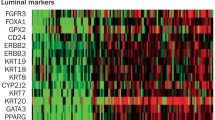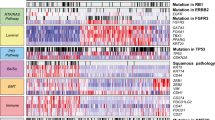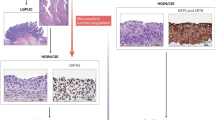Abstract
Purpose of Review
Recent whole genome characterizations of primary human bladder cancers revealed that they can be grouped into “intrinsic” basal and luminal molecular subtypes. Here, we provide an overview of the subtypes and discuss their biological and clinical properties.
Recent Findings
Basal cancers are characterized by advanced stage and metastatic disease at presentation. They tend to be enriched with squamous and small cell/neuroendocrine features and inactivating mutations and deletions of TP53 and RB1. Basal cancers can be divided into “epithelial” and “mesenchymal” (also known as “claudin low”) subsets, and a portion of the latter form a “neuroendocrine/neuronal” subset that is associated with particularly poor survival. Luminal cancers are often enriched with papillary histopathological features and activating mutations in FGFR3, and they can also be divided into additional subsets based on differential stromal cell infiltration, relative genomic instability, and high- versus low-level expression of carcinoma in situ (CIS) gene expression signatures. Importantly, the bladder cancer molecular subtypes display differential sensitivities to neoadjuvant chemotherapy and immune checkpoint blockade, and preliminary data also suggest that they respond differently to radiation with or without hypoxia modulation. Ongoing studies are investigating the relevance of the molecular subtypes to the bladder cancer histopathological variants and to upper tract urothelial cancer.
Summary
The bladder cancer molecular subtypes were associated with different prognoses and responses to conventional and targeted therapies in retrospective studies. If validated in prospective studies, molecular subtyping will be integrated into bladder cancer clinical management.
Similar content being viewed by others
References
Papers of particular interest, published recently, have been highlighted as: • Of importance •• Of major Importance
Alizadeh AA, Eisen MB, Davis RE, Ma C, Lossos IS, Rosenwald A, et al. Distinct types of diffuse large B-cell lymphoma identified by gene expression profiling. Nature. 2000;403(6769):503–11.
Berns A. Gene expression in diagnosis. Nature. 2000;403(6769):491–2.
Perou CM, Sørlie T, Eisen MB, van de Rijn M, Jeffrey SS, Rees CA, et al. Molecular portraits of human breast tumours. Nature. 2000;406(6797):747–52.
Blaveri E, Simko JP, Korkola JE, Brewer JL, Baehner F, Mehta K, et al. Bladder cancer outcome and subtype classification by gene expression. Clin Cancer Res. 2005;11(11):4044–55.
Dyrskjot L, et al. Identifying distinct classes of bladder carcinoma using microarrays. Nat Genet. 2003;33(1):90–6.
Sanchez-Carbayo M, Socci ND, Lozano J, Saint F, Cordon-Cardo C. Defining molecular profiles of poor outcome in patients with invasive bladder cancer using oligonucleotide microarrays. J Clin Oncol. 2006;24(5):778–89.
Lindgren D, Frigyesi A, Gudjonsson S, Sjodahl G, Hallden C, Chebil G, et al. Combined gene expression and genomic profiling define two intrinsic molecular subtypes of urothelial carcinoma and gene signatures for molecular grading and outcome. Cancer Res. 2010;70(9):3463–72.
Sjodahl G, Lauss M, Lovgren K, Chebil G, Gudjonsson S, Veerla S, et al. A molecular taxonomy for urothelial carcinoma. Clin Cancer Res. 2012;18(12):3377–86.
• Aine M, Eriksson P, Liedberg F, Sjödahl G, Höglund M. Biological determinants of bladder cancer gene expression subtypes. Sci Rep. 2015;5:10957. This was the first study to recognize the significance of the "neuroendocrine" subtype of basal cancers. This observation was reproduced in the second TCGA bladder cancer paper, where it was associated with the shortest disease-specific survival.
Sjodahl G, et al. Molecular classification of urothelial carcinoma: global mRNA classification versus tumour-cell phenotype classification. J Pathol. 2017;242(1):113–25.
Damrauer JS, Hoadley KA, Chism DD, Fan C, Tiganelli CJ, Wobker SE, et al. Intrinsic subtypes of high-grade bladder cancer reflect the hallmarks of breast cancer biology. Proc Natl Acad Sci U S A. 2014;111(8):3110–5.
Choi W, Porten S, Kim S, Willis D, Plimack ER, Hoffman-Censits J, et al. Identification of distinct basal and luminal subtypes of muscle-invasive bladder cancer with different sensitivities to frontline chemotherapy. Cancer Cell. 2014;25(2):152–65.
Cancer Genome Atlas Research Network. Comprehensive molecular characterization of urothelial bladder carcinoma. Nature. 2014;507(7492):315–22.
Rebouissou S, Bernard-Pierrot I, de Reynies A, Lepage ML, Krucker C, Chapeaublanc E, et al. EGFR as a potential therapeutic target for a subset of muscle-invasive bladder cancers presenting a basal-like phenotype. Sci Transl Med. 2014;6(244):244ra91.
Ho PL, Kurtova A, Chan KS. Normal and neoplastic urothelial stem cells: getting to the root of the problem. Nat Rev Urol. 2012;9(10):583–94.
Choi W, Ochoa A, McConkey DJ, Aine M, Höglund M, Kim WY, et al. Genetic alterations in the molecular subtypes of bladder cancer: illustration in the Cancer Genome Atlas Dataset. Eur Urol. 2017;72(3):354–65.
McConkey DJ, Choi W, Dinney CP. New insights into subtypes of invasive bladder cancer: considerations of the clinician. Eur Urol. 2014;66(4):609–10.
Kardos J, Chai S, Mose LE, Selitsky SR, Krishnan B, Saito R, et al. Claudin-low bladder tumors are immune infiltrated and actively immune suppressed. JCI Insight. 2016;1(3):e85902.
Robertson AG, Kim J, al-Ahmadie H, Bellmunt J, Guo G, Cherniack AD, et al. Comprehensive molecular characterization of muscle-invasive bladder cancer. Cell. 2017;171(3):540–556.e25.
Volkmer JP, Sahoo D, Chin RK, Ho PL, Tang C, Kurtova AV, et al. Three differentiation states risk-stratify bladder cancer into distinct subtypes. Proc Natl Acad Sci U S A. 2012;109(6):2078–83.
Mo Q, Nikolos F, Chen F, Tramel Z, Lee YC, Hayashi K, et al. Prognostic power of a tumor differentiation gene signature for bladder Urothelial carcinomas. J Natl Cancer Inst. 2018;110:448–59.
• McConkey DJ, et al. A prognostic gene expression signature in the molecular classification of chemotherapy-naive urothelial cancer is predictive of clinical outcomes from neoadjuvant chemotherapy: a phase 2 trial of dose-dense methotrexate, vinblastine, doxorubicin, and cisplatin with bevacizumab in urothelial cancer. Eur Urol. 2016;69(5):855–62. This was the first paper to recognize that basal bladder cancers were associated with the greatest clinical benefit from neoadjuvant chemotherapy. This observation was confirmed and expanded in the paper by Seiler et al.
•• Seiler R, Ashab HAD, Erho N, van Rhijn BWG, Winters B, Douglas J, et al. Impact of molecular subtypes in muscle-invasive bladder cancer on predicting response and survival after neoadjuvant chemotherapy. Eur Urol. 2017;72(4):544–54. This study described the development of a clinically-available single-sample bladder cancer subtype classifier. Using large retrospective tumor cohorts, the authors concluded that patients with basal tumors were the only ones to obtain signficant survival benefit from neoadjuvant chemotherapy. This paper was voted "paper of the year" at the 2018 European Association of Urology's Annual Meeting.
•• Rosenberg JE, Hoffman-Censits J, Powles T, van der Heijden MS, Balar AV, Necchi A, et al. Atezolizumab in patients with locally advanced and metastatic urothelial carcinoma who have progressed following treatment with platinum-based chemotherapy: a single-arm, multicentre, phase 2 trial. Lancet. 2016;387(10031):1909–20. This study led to FDA approval of the anti-PDL1 antibody in patients with advanced bladder cancer. It was also the first to demonstrate differential clinical benefit as a function of tumor molecular subtype membership.
• Mariathasan S, Turley SJ, Nickles D, Castiglioni A, Yuen K, Wang Y, et al. TGFbeta attenuates tumour response to PD-L1 blockade by contributing to exclusion of T cells. Nature. 2018;554(7693):544–8. The paper linked the highest clinical benefit to the Lund "genomically unstable" subtype and identified a gene expression signature associated with resistance.
Geynisman DM, Handorf E, Wong YN, Doyle J, Plimack ER, Horwitz EM, et al. Advanced small cell carcinoma of the bladder: clinical characteristics, treatment patterns and outcomes in 960 patients and comparison with urothelial carcinoma. Cancer Med. 2016;5(2):192–9.
• Guo CC, Dadhania V, Zhang L, Majewski T, Bondaruk J, Sykulski M, et al. Gene expression profile of the clinically aggressive micropapillary variant of bladder Cancer. Eur Urol. 2016;70(4):611–20. The original descriptions of the molecular subtypes recognized that squamous histopathological features were enriched in basal tumors. This paper extended these observations by showing that tumors with micropapillary features were enriched in luminal tumors. It is possible that each of the variants is characterized by a basal or luminal bias.
Dadhania V, Zhang M, Zhang L, Bondaruk J, Majewski T, Siefker-Radtke A, et al. Meta-analysis of the luminal and basal subtypes of bladder cancer and the identification of signature immunohistochemical markers for clinical use. EBioMedicine. 2016;12:105–17.
Warrick JI, Kaag M, Raman JD, Chan W, Tran T, Kunchala S, et al. FOXA1 and CK14 as markers of luminal and basal subtypes in histologic variants of bladder cancer and their associated conventional urothelial carcinoma. Virchows Arch. 2017;471:337–45.
• Hedegaard J, Lamy P, Nordentoft I, Algaba F, Høyer S, Ulhøi BP, et al. Comprehensive transcriptional analysis of early-stage urothelial carcinoma. Cancer Cell. 2016;30(1):27–42. This was the first "TCGA-like" large-scale profiling effort with non-muscle invasive bladder cancers. The paper identified 3 molecular subtypes, two of which were very similar to the "urothelial A" and "genomically unstable" subtypes identified previously by the Lund group.
Hurst CD, Alder O, Platt FM, Droop A, Stead LF, Burns JE, et al. Genomic subtypes of non-invasive bladder cancer with distinct metabolic profile and female gender bias in KDM6A mutation frequency. Cancer Cell. 2017;32(5):701–15.
Author information
Authors and Affiliations
Corresponding author
Ethics declarations
Conflict of Interest
David J. McConkey and Woonyoung Choi declare they have no conflict of interest.
Human and Animal Rights and Informed Consent
This article does not contain any studies with human or animal subjects performed by any of the authors.
Additional information
This article is part of the Topical Collection on Genitourinary Cancers
Rights and permissions
About this article
Cite this article
McConkey, D.J., Choi, W. Molecular Subtypes of Bladder Cancer. Curr Oncol Rep 20, 77 (2018). https://doi.org/10.1007/s11912-018-0727-5
Published:
DOI: https://doi.org/10.1007/s11912-018-0727-5




